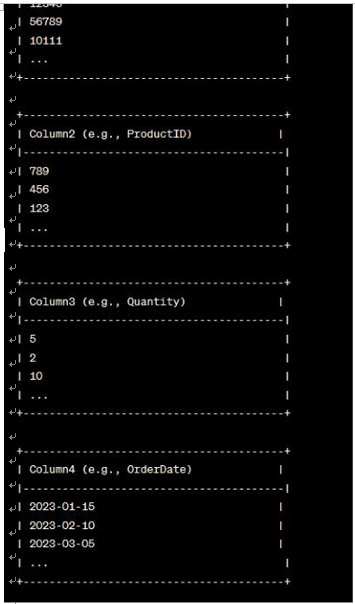ORC file format – Describe core data concept
ORC file format
The optimized row columnar (ORC) file format is designed to optimize performance and storage efficiency for big analytics. It leverages columnar storage and advance compression techniques to deliver high-speed data processing and a reduced storage footprint.
Let’s say you have an ORC file that stores sales data for an e-commerce company. Instead of storing data in a row-by-row format, ORC organizes the data into columns, as shown in Figure 1-8.
- Each column contains data of a specific type (e.g., integers, strings, dates).
- Data within each column is stored together, which allows for efficient compression and encoding.
- Rows are typically stored in stripes for further compression and optimization.
ORC files offer several advantages. The columnar storage approach reduces disk I/O by reading only the necessary columns during data processing, resulting in faster query perfor-mance. Additionally, ORC utilizes advanced compression techniques, such as RLE, dictionary encoding, and bloom filters, to minimize storage requirements while maintaining data integ-rity. These optimizations make ORC a highly efficient format for big data analytics and data warehousing.
The OCR file format is widely adopted in big data ecosystems, including Apache Hadoop and Apache Hive. Its compatibility with various data processing tools and frameworks makes it a popular choice for optimizing data processing pipelines. By leveraging the benefits of ORC, you can achieve significant performance gains and storage savings when dealing with large-scale data analytics
12 CHAPTER 1 Describe core data concept

FIGURE 1-8 The ORC file format
Describe types of databases
Effective data management is essential in today’s world, where information fuels innovation and drives business success. Choosing the right database type plays a pivotal role in storing, retrieving, and analyzing data with efficiency and precision. Let’s journey through the realm of database types, where you will explore the diverse options available and their specific use cases. By gaining a deep understanding of these database types, you can make informed decisions that align with your unique data requirements and unlock the true potential of your data assets. Get ready to embark on an exploration of the vast landscape of databases, where choices abound and where the right selection can pave the way for streamlined data manage-ment and impactful analytics.
The rapid growth of digital data in recent years has led to the development of various database types, each tailored to address specific needs and data characteristics. In the context
Skill 1.2: Identify options for data storage CHAPTER 1 13
of the DP-900 exam, it is essential to have a comprehensive understanding of the characteristics, strengths, and use cases of different database types. Whether it’s the structured precision of relational databases, the flexibility of NoSQL databases, or the cloud-native capabilities of Azure databases, the right database choice sets the foundation for successful data manage-ment and empowers organizations to harness the full potential of their data assets.
